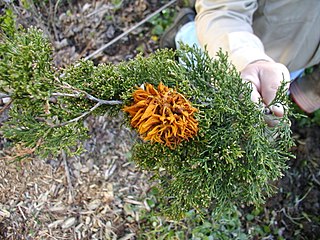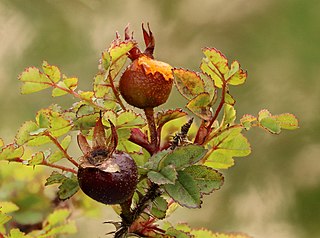
Basidiomycota is one of two large divisions that, together with the Ascomycota, constitute the subkingdom Dikarya within the kingdom Fungi. More specifically, Basidiomycota includes these groups: mushrooms, puffballs, stinkhorns, bracket fungi, other polypores, jelly fungi, boletes, chanterelles, earth stars, smuts, bunts, rusts, mirror yeasts, and the human pathogenic yeast Cryptococcus. Basidiomycota are filamentous fungi composed of hyphae and reproduce sexually via the formation of specialized club-shaped end cells called basidia that normally bear external meiospores. These specialized spores are called basidiospores. However, some Basidiomycota are obligate asexual reproducers. Basidiomycota that reproduce asexually can typically be recognized as members of this division by gross similarity to others, by the formation of a distinctive anatomical feature, cell wall components, and definitively by phylogenetic molecular analysis of DNA sequence data.

Gymnosporangium is a genus of heteroecious plant-pathogenic fungi which alternately infect members of the family Cupressaceae, primarily species in the genus Juniperus (junipers), and members of the family Rosaceae in the subfamily Amygdaloideae. The common name cedar-apple rusts has been used for these fungi. According to the Dictionary of the Fungi, there are about 57 species in the genus.

Rusts are plant diseases caused by pathogenic fungi of the order Pucciniales.

Diederich Franz Leonhard von Schlechtendal was a German botanist. The standard author abbreviation Schltdl. is used to indicate this person as the author when citing a botanical name.

Sanguisorba is a genus of flowering plants in the family Rosaceae native to the temperate regions of the Northern Hemisphere. The common name is burnet.

The stem, black, and cereal rusts are caused by the fungus Puccinia graminis and are a significant disease affecting cereal crops. Crop species that are affected by the disease include bread wheat, durum wheat, barley and triticale. These diseases have affected cereal farming throughout history. The annual recurrence of stem rust of wheat in North Indian plains was discovered by Prof. K.C. Mehta. Since the 1950s, wheat strains bred to be resistant to stem rust have become available. Fungicides effective against stem rust are available as well.

Teliospore is the thick-walled resting spore of some fungi, from which the basidium arises.

The Clavariaceae are a family of fungi in the order Agaricales. Collectively, they are commonly known as coral fungi due to their resemblance to aquatic coral, although other vernacular names including antler fungi, finger fungi, worm mold, and spaghetti mushroom are sometimes used for similar reasons.

Phragmidium rosae-pimpinellifoliae is a species of fungus in the family Phragmidiaceae. A plant pathogen, it causes a rust on the stem, leaves, petioles and fruits of burnet rose and related hybrids. The fungus is found in Europe and North America.

Sarcodon is a genus of fungi in the family Bankeraceae, which is part of the order Thelephorales known for its almost universal ectomycorrhizal life style. The genus owes its name to the presence of teeth-like spines on the hymenophore, it is derived from ancient Greek; sarco = flesh and odon = tooth. This is why they are commonly called "tooth fungi", or "Hydnoid fungi".
Hypovirus is a genus of viruses, in the family Hypoviridae. Fungi serve as natural hosts. There are currently four species in this genus including the type species Cryphonectria hypovirus 1. Diseases associated with this genus include: host virulence reduction.

Phragmidium is a genus of rust fungus that typically infects plant species in the family Rosaceae. It is characterised by having stalked teliospores borne on telia each having a row of four or more cells. All species have a caeoma which is a diffuse aecidium lacking a peridium.
Xenodochus is a genus of beetles in the family Carabidae, containing the following species:

Eupatorium macrocephalum Less. aka pompom weed, is a cosmopolitan perennial plant belonging to the family of Asteraceae and regarded as an invasive weed in some countries. It is native to the southern United States, Central America, South America and was introduced to South Africa. It is classed as a principal weed in Brazil. In South Africa it has been cultivated as an ornamental, is often found on roadsides, and has become of concern for its invading of undisturbed climax grassland and wetlands since the 1960s. It is closely related to Siam weed, and is one of some 268 species in the genus.

Gymnoconia interstitialis, otherwise known as orange rust of raspberries, is a well-known disease of raspberries and blackberries throughout the eastern United States and southern Canada. The disease targets the usefulness of the leaves, attacking them until they die and fall off of the plant. The disease returns annually, and this recurrence essentially makes the plants worthless—rarely do affected plants recover. Some strains have such a strong impact on the plants that the cultivation becomes unprofitable. Hesler & Whetzel (1917) claim, "Ten per cent rusty plants are frequently reported. Twenty-five per cent or more are recorded."
Keroplatus is a genus of predatory fungus gnats in the family Keroplatidae. Several species are bioluminescent.
Haematochiton is a genus of pleasing fungus beetles in the family Erotylidae. There are at least three described species in Haematochiton.
Goniocloeus is a genus of fungus weevils in the beetle family Anthribidae. There are at least 40 described species in Goniocloeus.
Zygostigma australe is a species of flowering plant in the family Gentianaceae native to South America. It was originally described as Sabattia australis in 1826 and transferred to the genus Zygostigma, of which it is the only member, in 1908.













